Low back pain is a common phenomenon that occurs regardless of age, but more often in adults. There can be many reasons - from physiological factors to diseases. Sometimes back pain appears briefly and passes quickly. However, pain in the lumbar region can be a sign of serious illness, and in these cases, an urgent need to see a doctor.
Reasons
The causes of acute back pain are many; they are strictly individual for each sufferer. The most important of them is diseases and changes in the spine, which can respond with irreversible consequences.
Basic (most common)
The most common reasons are:
- Osteochondrosis. Awkward movement provokes pressure on the roots of the nerve trunk of the spinal cord. Burning and whining do not stop during the day, if you lift something heavy, there is just hellish pain in the lower back.
- Herniated disc. Typically, a hernia is localized in the lower back, and any sudden movement of the trunk leads to compression of the nerve roots.
- Radiculitis. With lumbosacral radiculitis, a shooting pain syndrome occurs. It provokes heavy lifting or unsuccessful movements. The sharp pain constrains the patient's movements so much that he is not able to straighten and remains in the same position in which he was when the attack occurred.
- Displacement of the vertebrae. This problem is characterized by shooting pain in the lower back and slightly lower, stiffness of movement. This pathology is accompanied by disorders of urination and bowel function.
- Facet Syndrome. When the facets of the intervertebral discs expand both above and below, the intervertebral foramen decreases. In this case, unpleasant sensations arise that come suddenly and occur more than once a month. Leaning back, the patient experiences back discomfort.
- Epidural abscess. The accumulation of pus in the spinal cord occurs due to infectious diseases of the urinary tract. In addition to pain, fever, weakness and an increase in body temperature occur.
These are the causes - the consequences of diseases in the spinal cord.
The lower back can get sick due to the difference in the length of the legs of 2-3 cm. It is difficult for a person to move, an ache is felt in the back due to the constant curvature of the spine.
Overload and physical fatigue
In addition to serious illnesses, severe pain in the lumbar spine is also due to large overloads and a sharp forward tilt of the trunk. Also, this problem arises when the temperature effect on the body is violated. The sources of these pains are:
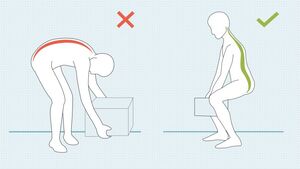
- Muscle Stretching. Exacerbation of muscle strain in the lower back occurs due to physical overload. Squeezing muscles causes pain and reduces mobility. This problem occurs in athletes and people who are engaged in intensive work.
- Neuralgia. Hypothermia of the back leads to neuralgia - irritation or compression of the nerves. Pathology manifests itself in different ways: sometimes in the form of seizures, accompanied by redness of the affected area, tremors, tissue edema and severe sweating.
- Myositis. Lumbar pain and discomfort begin at night, as well as with a sudden rise, with a change in weather conditions, after hypothermia and overexertion.
Frequent colds, decreased immunity, spinal injury after a blow or fall, both fresh and old, can provoke an attack.
Disorders of internal organs
Sometimes it hurts in the lumbar zone due to damage to other organs: heart, liver, kidneys, lungs, gallbladder. During inhalation, the pain syndrome from the lumbar region diverges along all the nerve channels. Often the causes of this pathology are:
- Pyelonephritis. It is an infectious inflammation of the kidneys and urinary tract. Usually the pain is dull, but attacks occur with chills, weakness, nausea and vomiting, and fever.
- Urolithiasis. The problem reveals itself as a sudden sharp pain that becomes unbearable with long walking and hard work. The attack is accompanied by nausea, vomiting, and blood in the urine.
- Ectopic pregnancy. If there is a rupture of the fallopian tube with miscarriage, shooting pain occurs, radiating to the groin, rectum. The rupture is accompanied by loss of consciousness, and with tubal miscarriage, a hematoma is formed in the peritoneal cavity.
- Pelvioperitonitis. This is a transient inflammatory process of the uterine appendages. The woman has excruciating pains in the groin and back. In addition to the existing unpleasant sensations, chills, fever and palpitations are added.
- Tumors of different origins. Cancer with metastases provoke painful attacks when pressure is applied to the nerve endings. Often, there are no initial signs of the disease.
Lesions of internal organs with bouts of severe pain in the lower back are more difficult to diagnose. Therefore, you should immediately contact a specialist or call an ambulance. In some cases, delay can lead to serious health problems and even death.
Soreness in the lower back is felt in almost all pregnant women. This is due to the restructuring of the body and an increase in the load on it. Also, difficult or complicated labor can be the cause.
Symptoms of Potential Diseases
Pain syndrome most often appears against the background of a pinched nerve, osteochondrosis, deformity and degenerative changes in the intervertebral discs, irritation of the nerve roots. Muscle spasms can also cause back discomfort in the lumbar region. Features of symptomatology for different diseases:
- With lumbago, changes begin in the lumbar vertebrae. At first, the acute pain can be controlled with medication. However, mobility remains constrained.
- With sciatica, the symptoms move lower - to the upper surface of the legs and buttocks. If there is no timely treatment, then the disease becomes a constant companion and can cause other diseases.
- Osteochondrosis provokes the development of other diseases of the spine. Therefore, pain can occur not only in the lower back, but also spread to the entire post.
- Scoliosis is characterized by curvature of the skeleton, degenerative changes. The chronic form may be asymptomatic, in other cases there is a pain in the bones.
- Dull and pulling pains are typical for diseases of internal organs (mainly of the genitourinary system and kidneys), benign and malignant tumors.
- With spondylitis, the pain is dull, aching, at first very weak. At the onset of the disease, it begins to ache in the lower back, movements become constrained. Gradually, the state of health worsens, the inflammation becomes more pronounced, it becomes difficult to move, even minimal loads are difficult to give.
- With spinal tuberculosis, in addition to pain, the body temperature rises. The person feels tired, weak, weak, appetite worsens. At night, there is severe sweating, frequent urge to urinate.
Views
Pain can be localized only in one place or "spread" over the abdomen, spine and lower back. Symptoms are acute, in the form of lumbago, dull and aching, encircling. It depends on the disease or pathological process.
Pain can be intermittent. Usually this is due to physical activity, physiological features, exacerbation of chronic pathologies. Constant, chronic pain occurs against the background of various diseases of internal organs, with vascular lesions, deformation of the musculoskeletal system.
Sharp
Sharp, strong, shooting pains lead to limited mobility. During such attacks, a person freezes in one position and cannot move. Even a slight stirring increases the already unbearable pain. This syndrome is called lumbago. Such symptoms can occur after intense massage or hypothermia.
Whining
Aching pains accompany chronic diseases, often appear with spondyloarthrosis. Symptoms usually occur at night, immediately after waking up or after long sitting in one position.
Pulling and dumb
These painful sensations can last for a long time, they exhaust the person. Most often they can be tolerated. Dull and pulling pains are uncommon for osteochondrosis, more for pathologies of the spine or damage to internal organs.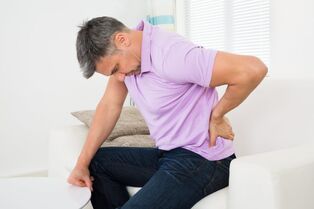 For example, with pyelonephritis, the kidney tissue swells a lot, the capsule stretches, which causes back pain.
For example, with pyelonephritis, the kidney tissue swells a lot, the capsule stretches, which causes back pain.
Shingles
Symptoms can appear in one place and radiate over the entire peritoneal region, "spreading" along the back. Girdle pain also affects the entire lower back. Without additional diagnostics, symptoms can be confused with diseases of the spine and joints. However, girdle pain usually causes pathology of the internal organs.
Localization of pain
In ankylosing spondyloarthritis, symptoms appear mainly in the lower back. Basically, the pain occurs in the morning, it can begin even late at night and gradually intensify, giving to the lower back. Also, discomfort in the lower back accompanies diseases of the pelvic organs, tailbone trauma, urological and gynecological pathologies, with the threat of miscarriage, after childbirth.
In the upper part, the symptomatology occurs with kyphosis, trauma, muscle myositis, osteochondrosis, infectious processes or tumors. Also, the cause can be gastrointestinal tract pathologies, gynecological, renal and heart diseases, pneumonia, pleurisy, influenza, ARVI.
Pain in the left or right side of the lower back appears due to disorders of the central nervous system, diseases of the spine and internal organs. Symptoms will appear from the side of the affected area. The emergence of negative sensations immediately in the left and right parts accompanies pleurisy, hepatitis, pneumonia, cholecystitis, inflammation of the prostate, and in women - the appendages.
Features in women and men
Some types of pain may only appear in women. For example, with gynecological diseases. Adnexitis is characterized by the appearance of discomfort in the lower abdomen. In this case, the pain sometimes radiates to the lower back. During pregnancy, the primary symptomatology occurs in the groin area, and radiates to the lower back due to an increase in the load on the spinal column. 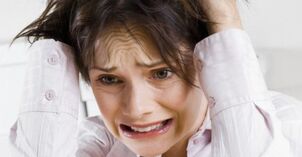 Low back pain occurs during labor, with the threat of miscarriage, in the late gestation period.
Low back pain occurs during labor, with the threat of miscarriage, in the late gestation period.
Menopause can be the cause of back pain in the lumbar region, when menstruation stops. The appearance of symptoms in the lumbar region is influenced by jumps in the level of estrogens, circulatory disorders, the initial stage of osteochondrosis, hernia and other diseases of the spine. The pain also arises as a result of stress, which women are more exposed to than men. In this case, the symptoms are periodic.
In men, back pain is more often associated with professional activities, risks - great physical exertion, hypothermia, work in a draft. There are a number of diseases that provoke the onset of negative symptoms in the lower back. With prostatitis, pain first appears in the anal area, but can radiate to the back. Epididymitis is characterized by an inflammatory process. Initially, the pain appears in the groin area, then it radiates to the lower back. At the same time, this is accompanied by an increase in temperature and swelling of the scrotum.
First Aid
What to do if hellish back pain spontaneously appears? The following steps should be taken immediately:
- Give your back absolute rest.
- Take a comfortable position, it is best to lie on a hard surface.
- You can put ice on the lower back, but before that put it on cheesecloth folded in 3-4 layers. This can only be done if the cause of the pain is not an organ infection.
- Apply a relaxing analgesic gel to the affected area.
- Take painkillers.
All these activities will help to quickly get rid of severe low back pain. But consultation and examination of specialists is necessary in order to identify the true cause of this attack and to prescribe adequate treatment.
What not to do
If there is a sudden pain in the back, doctors advise against using immediately warming ointments and gels. They stimulate blood flow to the sore spot, which contributes to an increase in swelling, and then an increase in pain. Before visiting a doctor or the arrival of an ambulance, it is completely and categorically excluded:
- Performing exercises of your own choosing.
- Washing in a sauna or steam bath, do not use contrast douches.
- Drinking alcohol to relieve pain.
Only a doctor after examination and diagnosis has the right to prescribe treatment for a sore lower back.
What to do next, which doctor should I see?
First you need to see a therapist. He conducts an initial examination, prescribes the necessary tests and, with the results obtained, sends him to a narrow specialist - a traumatologist, a surgeon, a neuropathologist. If the pain is associated with a malignant formation, an oncologist's consultation is necessary. When pathologies of the gastrointestinal tract become the cause - a gastroenterologist, with female ailments - a gynecologist, male - a urologist or proctologist.
Inspection and inspection
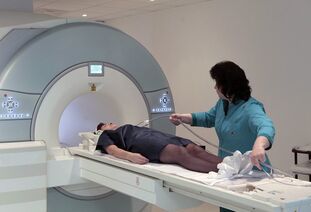
To find out why the lower back hurts, an initial visual examination is initially performed, followed by palpation. With its help, you can determine the localization of the symptom. The patient describes the nature of the pain, the duration of the attacks, after which it could appear (fall, physical activity). Further, a number of studies are carried out:
- Blood test. It can show inflammation, the presence of infection, tumors.
- Urinalysis. Allows you to exclude renal pathology. If the analysis is bad, an ultrasound is additionally prescribed.
- X-rays. Allows you to identify inflammatory processes, diseases of the spine, injuries, cracks, fractures, pinched nerve. Ideally, an x-ray of the spine and pelvic bones is done.
- CT. Tomography is more informative than X-ray, it can show small defects, a 3D image is created. At the same time, all bone structures are clearly visible.
- MRI. Provides an opportunity to explore soft tissues inside or near the spine. At the same time, the condition of the spinal cord, nerve roots, ligaments, muscles is checked. Hernias and vascular changes are clearly visible.
However, CT and MRI are only indicated for severe symptoms. Usually, x-rays or ultrasound, laboratory tests of blood and urine are sufficient.
Basic therapy
If lower back pain is caused by problems with the spine, then a comprehensive treatment of pathology is applied. It includes the following activities:
- organization of a gentle regime for the spine;
- conducting manual therapy;
- application of therapeutic massage;
- physiotherapy and reflexology sessions: acupuncture, UHF and others;
- drug therapy: medicines, ointment, blockade;
- wearing a special corset, if necessary;
- performing remedial gymnastics.
The main focus is drug therapy, which is primarily aimed at eliminating negative symptoms and relieving inflammation. As additional funds, physiotherapy, massage, exercise therapy are prescribed. In difficult cases, surgery may be required.
Medication Treatment
Anti-inflammatories are the first choice for back pain. They also relieve pain. Analgesics may be prescribed at the same time. Muscle relaxants are also prescribed. To reduce degenerative processes in the cartilage, chondroprotectors are prescribed. To relieve pain, drug blockages are sometimes done based on pain medications.
Topical ointments and gels are grouped into the following types:
- Means based on non-steroidal anti-inflammatory components.
- Combined preparations with anti-inflammatory effect and tissue cell restoration.
- Anesthetic and irritating agents.
- Homeopathic remedies.
- Chondroprotectors that promote the restoration of cartilage tissue.
- Massage products (cosmetic).
It is important to know that these methods can relieve pain, but cannot cure the root cause. For example, damage to internal organs, if lower back pain appeared due to this reason. In this case, you should undergo an examination, and a specialist will prescribe an effective treatment for this particular pathology.
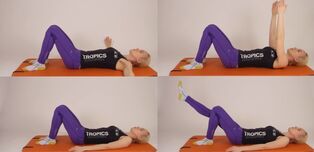
Exercise and massage
Exercise therapy (therapeutic gymnastics) and massage are recommended to strengthen the muscular frame of the back, normalize blood circulation, and increase tone. Exercise prevents back and lower back pain. The exercise therapy complex is selected individually. The massage reinforces the effectiveness of the exercises, restores the elasticity and flexibility of the ligaments. Combining it with a bath or sauna can only be allowed on medical advice.
Physiotherapy
Physiotherapy methods are prescribed only after acute attacks of lower back pain have been relieved. Then procedures help to reduce it or prevent an exacerbation. The following are used as physiotherapy:
- mud therapy;
- electrophoresis;
- balneotherapy;
- muscle electrical stimulation;
- phonophoresis (ultrasound);
- paraffin treatment;
- reflexology;
- amplipulse therapy.
The procedures help to reduce puffiness, have an analgesic effect, improve blood circulation, relax muscles, normalize metabolic processes and lymph flow.
Surgical
An absolute indication for surgery is cauda equina syndrome, when urinary and fecal incontinence occurs, and numbness appears in the perineum. Also, intervention is necessary if drug treatment is ineffective, lower back pain persists for more than six months and begins to radiate to the legs. Surgical operations are also performed in the presence of hernias.

Folk remedies
In addition, folk remedies can be used - infusions, decoctions from medicinal herbs. Compresses are made (for example, from chopped onions, fresh burdock leaves, boiled potatoes with horseradish, mustard). Rubbing with eucalyptus and burdock tincture, warm honey, a mixture of cologne, red pepper, iodine and valerian are used. For internal use, a tincture of vodka with saber or a decoction of wheat with coriander and milk is recommended.
Expert recommendations
If the soreness is felt for at least 3 months, it is considered acute pain. The following tips will help you to speed up recovery from acute low back pain and reduce its intensity:
- It is important to provide the patient with absolute rest for 2-3 days. You need to go to bed and take a comfortable position: lie on your side and put a pillow between your knees, or lie on your back and put a pillow under your knees. You cannot be stationary all day - it is recommended to get out of bed every 2-3 hours and warm up for 10-15 minutes.
- If pain cannot be tolerated, pain relievers and anti-inflammatory drugs should be taken regularly. Taking them only when the pain increases, you may not achieve the desired effect.
- Taking a warm shower every 3 hours or applying a heating pad for 10-15 minutes, or even cold, helps - this improves blood circulation, reduces pain and inflammation.
When you feel better, you should gradually return to your usual way of life. Prolonged lying on the bed contributes to muscle atrophy, and this aggravates the disease. You can train your body by walking or walking on the simulator - this is the simplest exercise for lumbar pain.
If lower back pain is not an independent disease, then it is a consequence of a serious illness that is present in the body. Therefore, you should immediately contact a medical institution to identify pathology and competent treatment.































